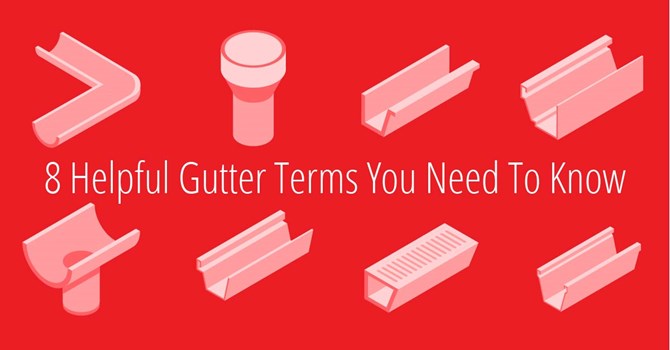8 Helpful Gutter Terms You Need To Know

Gutters systems have their own sets of connecting parts which make them complete and functional. Whether you’re interested in new gutters or just need a couple of parts replaced, it’s important to understand common gutter terminology you may come across so you can feel confident in your gutter choice.
Gutter Terms
Downspout: Also known as a roof drain pipe or waterspout, a downspout is a vertical, enclosed pipe which runs down the length of your house. It’s fastened to the gutter via a hole and extends down to the ground level. The role of a downspout is to carry water from the gutter to the ground or a drain, preventing foundation damage, property erosion, and damage to landscaping.
End Cap: A flat piece which attaches to and closes off the end of a gutter. It can also be screwed into the eaves of your home. End caps give gutters a more finished look and prevent excess debris and water from flowing out of the gutter.
Fascia: A long, horizontal board which runs along the lower edge of the roof. It’s fixed directly to the lower ends of the roof trusses and provides a base for attaching gutters. Fascia gives the roof edge a more finished look and protects the roof and the interior of the home from water damage.
Gauge: A measure of the thickness of the gutter material. It can range from .019 to .032 inches with .032 being optimum for maximum strength.
Gutter: A shallow channel installed at or just below the roofline to collect rainwater and direct it away from the home. Gutters have a slight downward pitch to keep water from running down your exterior walls or eroding your home’s foundation. Gutters come in various shapes and sizes and are usually made of aluminum, copper, vinyl, zinc, steel, or wood.
Hangers: A pre-engineered bracket used to attach the horizontal section of the gutter to the fascia board. Hidden hangers can be installed inside the gutters so they can’t be seen from the front or below.
Pitch: The angle at which the gutter slants downward to force water to flow towards a downspout. If gutters are not sloped enough, their capacity is reduced and water will simply pool and spill over the sides.
Ice Dam: A thick ridge of ice which builds up along the lower edge of the roofline. Ice dams form when heat from the house melts snow on the roof. Water drains down to the eaves or the edge of your gutter where it freezes and the accumulating ice makes a dam. Clogged gutters are perfect places for ice dams, but they may break, bend, or become detached from the fascia if they hold too much weight.
For all your gutter needs, look to Couto Construction. Our experienced technicians can help you select the best gutter type and components to provide your home with a great appearance and the protection it needs. Contact us today for a free estimate if you need any gutter services in Southeastern Massachusetts, Cape Cod, and Rhode Island.